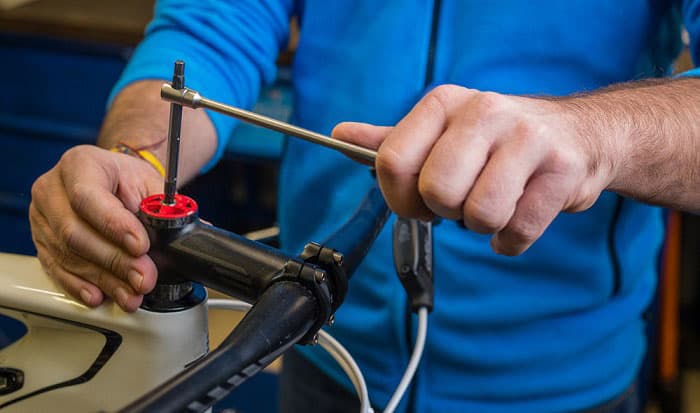Imagine you’re gliding effortlessly down a scenic bike path when suddenly, you hit a bump that sends a jolt through your entire body. As you regain your balance, you notice your handlebars have developed an annoying wobble. Loose handlebars, a common yet frustrating problem for cyclists, can compromise your safety and enjoyment on the road. But fear not, for in this comprehensive guide, we will empower you with the knowledge and techniques to quickly and effectively remedy this issue, ensuring your next ride is a smooth and worry-free experience.

Image: noahstrength.com
Loose handlebars can stem from various factors, including wear and tear, improper installation, or simply riding over rough terrain. Regardless of the cause, it’s essential to address this problem promptly to avoid potential accidents. Follow along as we delve into the step-by-step process of fixing loose handlebars, empowering you to tackle this task like a seasoned mechanic.
1. Identify the Loose Component
To pinpoint the source of the looseness, grab the handlebars firmly with both hands and gently rock them back and forth. Observe where the movement occurs. Is it at the point where the handlebars connect to the stem, the headset, or both? Determining the exact location of the problem will guide your repair strategy.
2. Tighten the Handlebar Bolts
If the handlebars wiggle where they meet the stem, the issue likely lies with the handlebar bolts. Locate the bolts, usually situated on either side of the stem, and use an Allen key or hex wrench to tighten them. Apply moderate torque, but avoid overtightening as this could damage the bolts or the handlebar clamp.
3. Adjust the Headset
If the handlebars feel loose in relation to the frame, the headset may need adjustment. To check this, apply the front brake and rock the bike back and forth. Listen for any clicking or grinding noises, which indicate a loose headset. Tightening the headset is a slightly more involved process that requires specialized tools such as a headset wrench or cone wrench. Refer to your bike’s manual or consult a bike mechanic for guidance.

Image: iam-publicidad.org
4. Replace Worn-out Parts
Over time, frequent use and exposure to the elements can lead to wear and tear on handlebar components. If your handlebars are still loose despite tightening the bolts and adjusting the headset, it may be necessary to replace damaged or worn-out parts. This could include the headset bearings, stem, or even the handlebars themselves.
5. Lubricate Moving Parts
Lubrication is crucial for smooth operation and longevity of bike components. Apply a small amount of bicycle grease or oil to the contact points between the stem and handlebars, as well as the headset bearings. This will reduce friction, prevent wear, and ensure your handlebars remain snug and responsive.
6. Professional Help
If all else fails and you’re unable to fix the loose handlebars yourself, don’t hesitate to seek professional help from a bike mechanic. They possess the expertise and specialized tools to diagnose and resolve complex issues efficiently, ensuring your bike is in optimal condition.
Expert Tip: Regular Maintenance
Regular bike maintenance is the key to preventing loose handlebars and other common issues. Make it a habit to periodically check the tightness of handlebars, headset, and other critical components. By being proactive, you can save yourself time, money, and potential headaches down the road.
How To Fix Loose Handlebars On A Bike
Conclusion
Loose handlebars can be a frustrating inconvenience, but with the knowledge and techniques outlined in this guide, you’ll be able to diagnose and fix the problem with confidence. Remember, regular maintenance is crucial for keeping your bike in top shape, ensuring every ride is a safe and enjoyable experience. So, tighten those bolts, lubricate those parts, and hit the road with renewed confidence. The joy of a wobble-free ride awaits you!